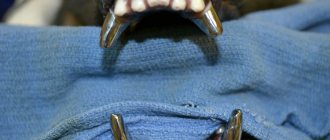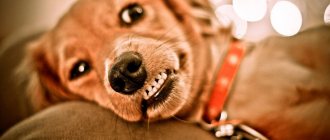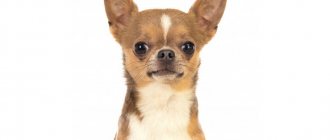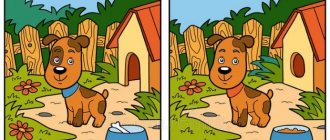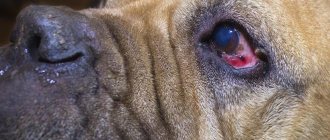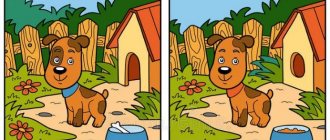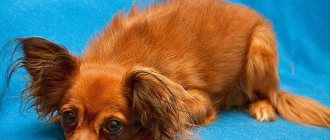The most active and cheerful “kids” are, of course, Chihuahuas. The world's favorites have earned special fame; they also need special care - oral care when a Chihuahua's teeth change. Small breeds are more prone to dental problems than large dog breeds. There is nothing wrong with this if you regularly monitor the condition of the teeth and, in principle, the hygiene of your pet. Let's find out when baby teeth change and how to prepare for this process.
Dental formula of Chihuahua dogs
The normal number of teeth in a Chihuahua is:
- 28 milk – in a puppy;
- 42 molars - in an adult dog.
Deviations from the specified values serve as grounds for disqualifying a dog at a breed show. In addition, during the examination of the mouth, experts pay special attention to the integrity of the teeth and the correctness of the bite. It should be scissor-shaped.
A Chihuahua puppy's dental formula looks like this:
- upper jaw: 6P+2K+6P;
- lower jaw: 6P+2K+6P.
For an adult representative of the breed, the formula is as follows:
- upper jaw: 6P+2K+8P+4M;
- lower jaw: 6P+2K+8P+6M,
where the types of teeth have the following symbols:
- P – incisors;
- K – fangs;
- P – premolars;
- M – molars.
From the formulas it follows that molars are exclusively permanent teeth. They are also commonly called indigenous. This is evidenced by the translation from English of the word - molar.
Possible disorders and pathologies
As soon as the puppy begins to change teeth, the health of the oral cavity and the general well-being of the pet must be closely monitored. Some breeds have a tendency to delay the replacement of baby teeth and develop oral diseases.
If you do not have experience in keeping dogs, it is better to take your baby to the vet at the age of 8-10 weeks. Delay associated with possible complications may result in irreversible malocclusion.
Gum inflammation
Inflammation of the gums, these are the consequences:
- The eruption of teeth that are too large is a genetic factor.
- The formation of “hoods” of gums, under which food remains and rots.
- Poor nutrition.
In case of severe inflammation, the puppy is prescribed procedures to maintain oral hygiene, or, in extreme cases, anti-inflammatory drugs.
Persistent teeth
Persistent teeth are a phenomenon where molars grow in before baby teeth fall out. This disorder is serious and can lead to permanent changes in the bite and crooked teeth.
In addition, baby teeth begin to rot, which leads to the rapid proliferation of pathogenic microflora and the occurrence of gum inflammation. The problem of “double rows” of teeth is solved surgically - the veterinarian removes the milk teeth that have not fallen out.
Diarrhea is a common consequence, or more precisely, an “accompanying factor” of the change of baby teeth. Diarrhea can occur for no apparent reason and usually resolves without intervention. The only factor that the owner needs to monitor is the development of dehydration. The smaller the puppy, the faster his body loses water through diarrhea.
Diarrhea can be a symptom of serious viral diseases, the first symptoms of which are often missed because they are attributed to poor health due to changing teeth.
Smell from the mouth
Bad breath from a puppy during teething usually indicates decay. When bad breath occurs, it is important to find out the cause:
- Rotting food that remains under the gums.
- Rotting of teeth due to the proliferation of pathogenic microflora in the mouth.
- Disruption of the gastrointestinal tract.
At home, you need to examine your pet’s mouth for inflammation and the formation of gum hoods. If you don't see anything suspicious, it's best to contact your veterinarian immediately, as differential diagnosis is based on history, a thorough examination, and symptoms.
Poor appetite
Poor appetite is a completely natural consequence of the discomfort that a puppy experiences when changing baby teeth. You need to worry if the puppy refuses not only food, but also water. Refusal to eat is associated with discomfort that the puppy experiences when chewing. To make your pet's life partly easier, he can be switched to liquid or exclusively soft food.
We invite you to familiarize yourself with: Dogue de Bordeaux (French Mastiff): photo, character of the breed
Poor appetite may be associated with fever, nausea, or diarrhea. In this case, immediately contact your veterinarian. It is acceptable to monitor the puppy and the development of symptoms as long as he remains active, drinks and eats.
There are several types of complications during the period of teeth change.
Malocclusion
If the dog is preparing for a show career, malocclusion can be corrected with braces. In other cases, it is left as is.
Gum inflammation
Symptoms: severely reddened, swollen gums, drooling, poor appetite. In case of inflammation, too rough foods are excluded from the diet. If the inflammation does not go away, the veterinarian may prescribe a course of Stomadex.
Persistent teeth
This is a delay in the loss of baby teeth when permanent ones are already growing. It threatens with malocclusion, inflammation and injuries to the cheeks. You can help your dog by loosening an old tooth. If this cannot be done painlessly, contact your veterinarian.
Most of the pathological processes that occur with Chihuahua teeth are due to genetic characteristics. Representatives of this indigenous breed, which originated in Mexico, often exhibit hereditary lack of teeth, that is, the disorder was passed on to modern dogs from their distant ancestors.
The situation is significantly aggravated by incompetent breeding, when unscrupulous breeders have one goal - to make a profit. They use individuals with pathologies for mating, thereby passing on the disorders to the next offspring.
Chihuahuas have a tendency to almost all diseases of the oral cavity, and they can be detected at any age of the pet. The situation is complicated by the fact that even high-quality care cannot protect against them 100%, since there is a hereditary component. What can owners of sneezes face?
Retention
We are talking about delayed growth of bone formations, which is more often associated with molars, less often – with milk teeth. The fact is that even if one of them is “delayed,” the overall process is slowed down. For example, many owners of dogs of this breed note that their pets completed a full change only at 8-9 months, and sometimes only at one year of age.
Experts identify the main causes of retention: heredity, weakened immune system, infectious diseases, periodontal disease and other gum diseases, helminthic infestation, lack of vitamins and microelements. The pathology can be either complete or partial; in the second situation, the tooth erupts, but remains in an underdeveloped state.
Dystopia
This pathology is a consequence of retention. A tooth that has not grown in its time begins to do this out of turn, and since the dentition has already formed, this happens outside of it. Such a violation leads to the following conditions:
- staggered placement of canines and incisors (this rarely applies to molars and premolars) - in this case, the enamel is often covered with tartar, increasing the risk of developing inflammatory processes;
- If the fangs are placed incorrectly, there is a risk of injury to the surface of the palate.
It is not uncommon for Chihuahuas to have a second set of teeth, when the eruption of molars occurs earlier than the loss of primary teeth. If the problem is detected in time, you can contact a veterinarian to remove the crooked tooth. This will give the rest the opportunity to cut through correctly.
If the dog has already grown two rows of teeth, the milk teeth must also be removed to avoid rotting. But it is no longer possible to correct the curvature of the incisors and fangs. It is impossible to predict the development of dystopia, but it is possible to control the process.
From the age of 3 months, thorough examinations of the pet’s oral cavity should be carried out. In order to detect erupting double teeth in time, it is worth palpating the back of the gums. If crooked molars are healthy and do not cause injury to the jaws, they are not removed.
Oligodontia
Another pathology that sneeze owners face is missing teeth. With this pathology, voids form in the dentition, which provokes a shift in adjacent teeth.
Polydontia
The pathology is also called supernumerary, when the dog has more teeth than it should. There are two forms of polydontia - false (with preservation of milk teeth) and true. The latter is classified as mutational changes.
Malocclusion
According to the standard, a Chihuahua's bite should be correct, scissor-shaped, and there should be no gaps between the incisors. When giving an expert assessment, experts pay special attention to the placement of rows, since individuals with malocclusion are rejected and not allowed for breeding.
It is worth noting that if the International Canine Organization is more strict towards Chihuahuas and allows only a scissor bite, the American Club also allows individuals with a direct closure to participate in exhibitions.
Age when baby teeth erupt
Chihuahua puppies are born completely deaf, blind and toothless. The first milk teeth erupt at 2-3 weeks of life. The first to cut are the incisors, then the canines, and the premolars complete the chain. The final size of baby teeth is reached after 2-3 months.
Veterinarians and experienced breeders, due to the increased consumption of calcium by the growing body, advise diluting the puppy’s diet with calcium supplements. A mineral mixture that has proven itself well is Beaphar Junior Cal.
Duration of treatment is 2-3 weeks. Specialist consultation is required.
General information
Small-breed Chihuahuas often participate in exhibitions, so the main task for the owner is to monitor the dog and its growth, take it to the veterinarian and carry out preventive measures with vaccination. One of the main issues that can be solved is brushing your teeth on time and removing plaque. Even if the dog is not a participant in exhibitions, it is necessary to brush its teeth.
Experienced dog breeders advise rinsing the mouth or wiping it with a decoction of oak bark. This is necessary to strengthen the gums and prevent inflammation when changing teeth.
Small puppies have no teeth from birth, but by about 2 weeks they have their first baby teeth. This is not associated with anything unpleasant - a completely natural process that ends with the appearance of four canines, 8 incisors, premolars and molars. How many of them there should be is an individual question for each dog.
Chihuahua is a special breed; it has a rather fragile skeletal system, including its jaws. If teeth are not kept in the correct order, the bite may change from a scissor bite to an overbite or undershot bite. To avoid such problems and to allow you to participate in the exhibition, know that the front teeth grow first, and the canines often linger for a long time and do not fall out because they have strong roots.
READ Cleanliness Guide: How to Wash and Bathe Your Puppy
If you notice similar problems - redness of the gums, swelling, restlessness of the dog, and so on, try to loosen the baby tooth, but it is better to seek help from a specialist. Anesthesia for dogs during tooth extraction is considered dangerous, so try to do without it.
Scheme of changing temporary teeth to permanent ones
The physiological change of teeth in a Chihuahua usually begins at four months of age and is completed by 8-9 months. Under mechanical pressure, baby teeth begin to loosen and fall out, and permanent ones grow to replace them. A Chihuahua's teeth change in the following order:
- incisors (4 months);
- premolars (5 months);
- molars (5-6 months);
- Fangs (at the age of 5-7 months).
This is in theory, but in practice the timing and sequence often do not correspond to reality. Experts have found that the timing of teeth change in Chihuahuas depends on the actual size of the puppy. The smaller it is, the longer the process will take.
Other reasons for delayed teeth change in a Chihuahua puppy include:
- insufficient development of masticatory muscles;
- calcium deficiency in the puppy’s body and diet;
- genetic predisposition to pathology;
- displacement or damage to the molar tooth germ.
If, upon reaching the age of nine months, not all of your Chihuahua’s baby teeth have fallen out, be sure to contact a veterinary clinic to have them promptly removed. The cost of the service starts from 300 rubles. The procedure is safe and is usually performed under local anesthesia and sedatives. In severe cases, general anesthesia is required.
Note: vaccination of a Chihuahua puppy is carried out BEFORE the start of the process of changing teeth, or AFTER its completion, because... During this time period, the dog’s immunity is reduced.
Cleaning Methods
Special toys or treats
With the help of such devices you can clean your pet’s teeth quite well..
Before giving a puppy or adult Chihuahua such a toy or treat, you need to make sure that the item does not have sharp edges or corners that could injure the dog, and that the device itself is soft enough and will not harm the teeth.
Toothbrush for dogs
It is not difficult to choose a brush and toothpaste suitable for your Chihuahua: pet stores have a large selection of such devices.
In this case, you need to take into account not only the size of the brush, but also the stiffness of its bristles: for a Chihuahua it should be minimal.
When choosing toothpaste for your pet at a pet store, you need to give preference to one that does not have to be washed off . You should not brush your Chihuahua's teeth at home with anything other than toothpaste intended for dogs.
Ultrasound
This method is suitable for cleaning teeth if plaque has already turned into tartar and it is impossible to remove it with a brush and paste.
To carry out this procedure, you should contact a veterinary clinic.
What to do if teeth grow in two rows?
In Chihuahuas, a double row of teeth is often fixed in veterinary practice. This is because the puppy’s dentofacial apparatus is not provided with sufficient load. In rare cases, the cause lies in genetic predisposition. If prompt action is not taken, the consequences of the pathology will be serious:
- difficulty chewing food;
- bite deformation, jaw misalignment;
- damage to gums and nearby teeth.
I advise you to contact a veterinarian. Extracting baby teeth on your own can lead to infection. If this happens, treat the inflamed gum with a decoction of chamomile or oak bark.
Antibacterial care for Chihuahuas
To clean the teeth of small dogs, the antibacterial agent “Stomadex” is also used. It is used in courses - one Stomadex tablet is given to the dog for 10 days twice a year. How to use the drug: The tablet is placed under the pet’s upper lip. Saliva gradually dissolves the tablet, the substance it secretes protects the teeth.
Hygienic care for Chihuahuas may also include special bones containing bone meal. Also, in order to prevent the formation of tartar, it is allowed to give your pet special biscuits that a small dog can chew. Bones and biscuits are sold in pet stores.
Hydrogen peroxide can be used to whiten and clean enamel from plaque. The composition is applied to a swab, which is used to wipe the pet’s teeth.
Chihuahuas must be groomed regularly. It is necessary to examine the animal's oral cavity daily. If a dog breeder notices that an unpleasant odor has appeared from the animal’s mouth, and it has stopped gnawing on hard bones, you should urgently go to the veterinarian, who will check the condition of the animal’s teeth.

